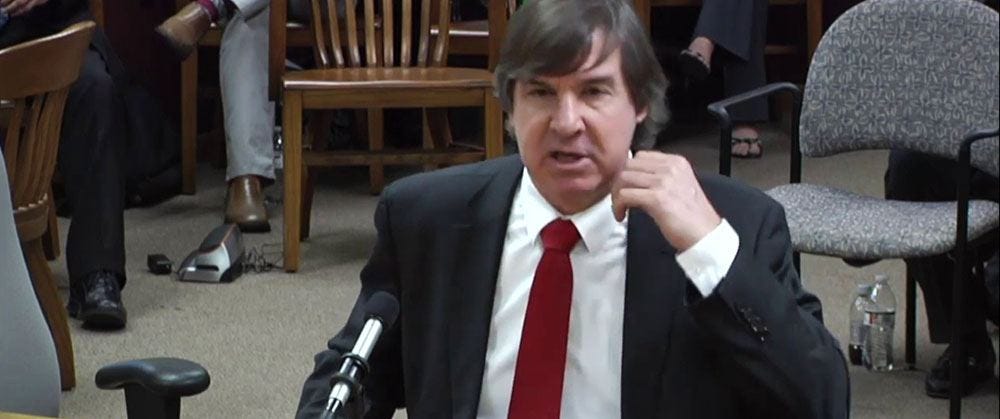Encouragingly, there does now finally appear to be a consensus amongst the tobacco control community: Smokers should be encouraged to use vaping products if they've been unable to quit using FDA approved stuff. To many in the vaping industry, this will appear to be missing the wood for the trees, but that's just the nature of consensus. It's a net positive, and could not have occurred even a year ago.
But the vaping industry remains unrepresented in this discourse. Delegates at yesterday's Summit did not come away from the event with anything like an incremental understanding of the true nature and character of vaping. It just wasn't in the room. The only industry present, either physically, or in the mind of the non-industry delegates, were the few larger players that are going through the PMTA motions.
Don't misunderstand me - it's great that companies are doing PMTAs, but for those of us that are actually part of the independent vape industry, Monday felt at times a little like being in a parallel reality. The vast knowledge, experience, insight and sum total of a billion human-to-human interactions in pursuit of 'actually-existing harm reduction', just did not surface. Instead, the conversation was around the PMTA agenda securing a future that consists of some (we don't know how many) reduced-harm products. The dangerous assumption is that this is sufficient or desirable and that this constitutes a true harm-reduction approach.
If you attended the Summit and don't recognize that as a truthful statement, let me prove it to you with a quick and easy task. Spend 10 minutes browsing my website, E-Cigarette Forum.Com. Get a sense of the vernacular, of the energy occurring between peers. Now realize (because you just have to trust me on this one), ECF (as we call it) is a big site, but it's barely even a speck compared with the true overall picture. Was this what was under discussion at the Summit? I don't believe so.
This is what harm reduction looks like now, in the actual world. It's a thing that should be treated with respect, curiousness and seriousness and not exclusion. The fundamental element of harm reduction is peer-to-peer education and interaction: harm reduction is a communication intervention. Thanks to the wonders of information technology, you can witness this in real time. What a privilege! Did you get a sense of this at the Summit?
This peer-to-peer interaction is the reason, as we heard, that 65% of American smokers are correctly informed that vaping products are safer than smoking, compared with some 30% of non-smokers. This peer-to-peer interaction is entirely facilitated by the vaping industry. Why is the vaping industry so good at doing this? Easy: because independent vaping innovation and the market for independent vape products is radically user driven. The category was founded and occupied by people who make and use these products.
There exists an assumption that all this can be placed by a few "harm reduction products". Matthew Myers, for example, stated that he's in support of harm reduction, but he's also in support of the deeming rule. This is a contradiction in terms, and I think it's a risky business killing this all off without any clarity over what will replace it.
The dearth of anything like a literature on the true picture of vaping in America is a problem.
In my opinion the main reason for this is structural (but I will note that many of my colleagues do not share this interpretation, which they would consider charitable at best): The fragmentation in ownership of the industry has led to a fragmentation in efforts to represent it at research, regulatory or tobacco control levels. In a sense, this industry is invisible despite being found on every Main Street.
This had led to a hinterland between "anecdote" and "literature" that the FDA wishes to fill with PMTAs. The FDA's impact assessments did not make evaluations of the existing public health contribution of vaping and, therefore, was not able to make any assessment of the effect on public health of its eradication. The entire issue was reduced to a footnote: "We anticipate 98.5% will exit".
But it's not entirely a structural issue. There has been no desire from the leadership in the research community to develop a knowledge base and to work with the user community. And, sadly, there's deep reciprocal mistrust of the Tobacco Controllers from vapers and vape businesses.
Instead of working with what should be their natural allies (it's not uncommon to hear vapers state: "Fuck Big Tobacco"!), for years the tobacco control community has occupied itself over an internal disagreement as to whether the notion of harm reduction can be countenanced. There are individuals that are responsible for this inertia. There are also individuals that are responsible for the dissemination of dangerously misleading information. But yesterday's Summit appears to have generated a consensus. So what next?
During the first E-Cigarette Summit in London, 2013, a panel was asked: "why is regulation necessary?". Professor Robert West replied (I'm paraphrasing): "I think we regulate when one of two things are true: Either we identify a problem that regulation needs to deal with, or we identify a way in which regulation can improve things. I don't see either answer being true in the case of e-cigarettes."
The construction of the Tobacco Act excuses the FDA from asking either of these questions. On the one hand, it's simply a statement of legal fact that it gives FDA a mandate to take action, and on the other, the onus is placed on the manufacturer to prove a product's public health benefit.
The net result of PMTAs is that the overwhelming majority of vape businesses are eliminated, the peer-to-peer networks, which revolve around these businesses, fall apart, and this thing is lost forever.
I think I know how Robert West's questions can be answered in the US case.
The first question: "what problem are we seeing that needs to be fixed", is problematic in the context of biased research agendas. This is solved by the rejection of bad research, and I think the overall picture that came out at the Summit was positive. The reason Professor West could say convincingly that he wasn't seeing a problem (actually, he was just starting to see the opposite of a problem) is because he runs the Smoking Toolkit Study. The US counterpart, PATH, is only now beginning to provide a truthful picture of vape (and smoking) in the USA.
Can regulation "make things better"? I think it can, in two ways. Firstly, a standards-based system can be adopted and made to work, perhaps mimicking the US Cosmetics model. This would provide American vapers with assurance as to the quality of products, and would identify, over time, any compounds that are problematic in inhalation. Contrary to Matt Myers, there is not an abundance of "awful products" out there, but there is an abundance of misleading information.
Secondly, a program should be initiated that seeks to leverage what vape-stores are already doing. This program would create an information exchange helping to encourage best-practice in helping smokers making the change. but it should be facilitative rather than coercive.
Product innovation should be encouraged. It's true that vape products are not yet good enough. Is there a way of incentivising innovation in vape? I don't know, but I do know that PMTA is disincentivising.
The hand-wringing over vape juice flavours needs to stop. Flavours are great - smokers love them. To me, the constant refrain of "flavours are just aimed at children" only serves to underscore the lack of compassion for smokers. Which other groups would be denied their pleasures so cavalierly? And doesn't the Declaration of Independence talk about the rights of Americans in the pursuit of their happiness?
In fact, I'll go further on flavours. I think they're a "hook"; a last ditch attempt to find something specifically problematic about e-cigs to justify a strongly held disgust-response to vaping. On the plus side, if people can get over the flavour issue, maybe the next step is a true change of mind.
I'll be following this piece up with an overview of the content of various presentations shortly. But I wanted to make note of a general sense of doubt over PMTAs. The new Administration, Cole-Bishop, lawsuits, and so forth have, I think, led to a general sense that the regulatory process embarked on in May last year will eventually take on a different character.
A Clarification
This piece was not intended to criticize in any way the Summit or Amanda Strange, who put on a masterful event, as usual (and who is, herself, a vaper).
I don't think the Summit could have projected the above narrative in this, first, US incarnation. But I do think it's worth noting that even those who now appear to provisionally support vaping, might only support a limited aspect of it - a "clean face" which is presented to them through access to a variety of social networks.
Amanda did, as she always does, make provisions for vapers to attend. I hope, as has happened with the UK Summits, that some connections were made that will prove fruitful for better understanding and co-operation in the future.






Leave a comment
This site is protected by hCaptcha and the hCaptcha Privacy Policy and Terms of Service apply.